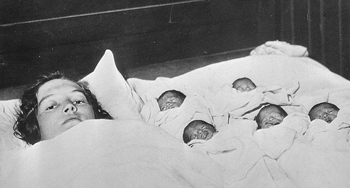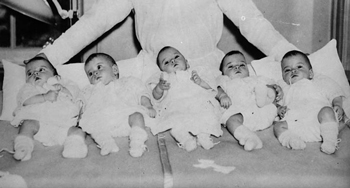The Dionne Quintuplets National Historic Event

Born to Elzire and Oliva Dionne, on 28 May 1934, the birth and survival of five identical, premature and undersized infants – Yvonne, Annette, Cécile, Émilie, and Marie – was an unprecedented event that captivated the world and brought attention to a small Ontario town. The quintuplets’ delivery and after care, which took place under difficult circumstances and without access to any medical equipment or facilities, was handled initially by experienced local midwives Mme. Donalda Legros and Mme. Benoit Lebel and country physician Dr. Allan Dafoe. The survival of the Dionne quintuplets was considered miraculous.
Born near the village of Corbeil in northern Ontario, the babies arrived nearly two months early and together weighed only 13 pounds, six ounces. The largest weighed 2-and-a-half pounds; the smallest weighed 1 pound, 8-and-a-half ounces. None were longer than 9 inches. The odds of naturally occurring quintuplets are thought to be about one in 55-57,000,000 but the odds of identical quintuplets are considered incalculable, due to the random nature of twinning. It appears the Dionnes are the only identical quintuplets ever recorded and the first ever quintuplets known to survive infancy.

Experienced local midwives, Madame Legros and Madame Lebel, worked together to deliver the first two babies. Dr. Allan Dafoe arrived in time to assist with the third birth and tended to the fourth and fifth. The midwives achieved a considerable degree of fame based on their role in the birth and their immediate care of the babies. Dafoe was a local country physician when he gained instant, international fame by helping to bring the Dionne quintuplets safely into the world. No one expected the babies to survive. Their early care was based on common sense and making do with what was available. Before supplies of breast milk could be organized, Dafoe ordered the babies to be fed a mix of cow’s milk, sterilized water and corn syrup. When they had difficulty breathing, he gave them a ten-part water, two-part rum solution to revive them. The babies were kept warm by the heat of an oven, hot water bottles or heated bricks until incubators could be obtained. It was under Dafoe’s direction that all five tiny, premature infants – born to a mother who had little prenatal care – not only survived but flourished, astounding the medical world.
The Ontario Government made the girls wards of the province and named Dafoe as one of the children’s three official guardians. They returned to their family in 1943.
The miraculous birth of the quintuplets in the midst of the Great Depression captured worldwide attention and they became a major tourist attraction. Today, Dafoe’s former home in Callander, Ontario, is a museum, and this designation is the result of the initiative of local heritage leaders there.
The National Program of Historical Commemoration relies on the participation of Canadians in the identification of places, events and persons of national historic significance. Any member of the public can nominate a topic for consideration by the Historic Sites and Monuments Board of Canada.
- Date modified :